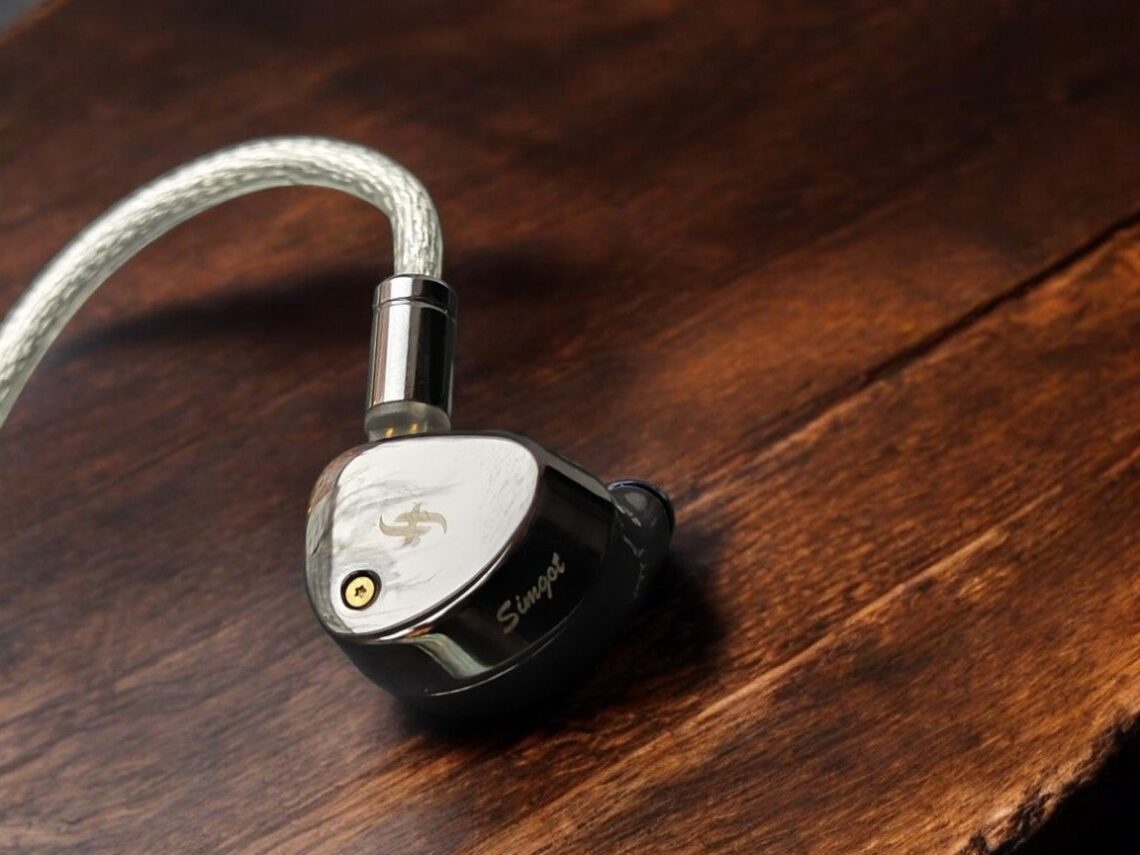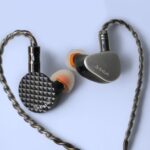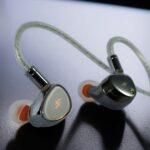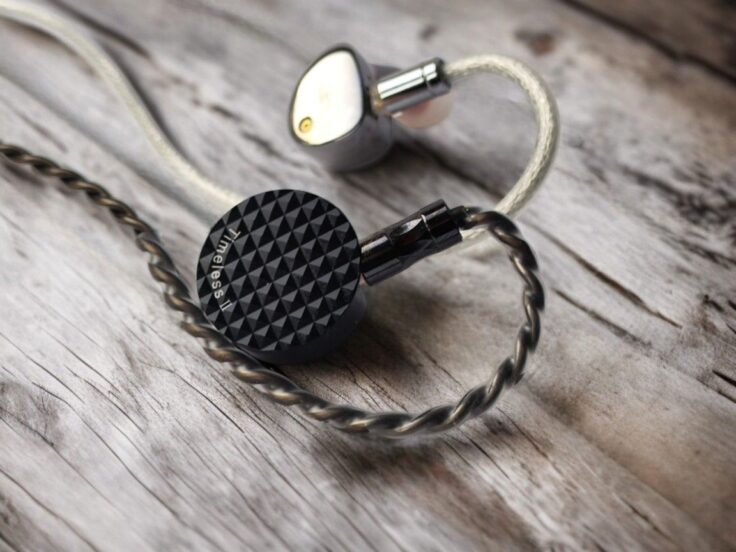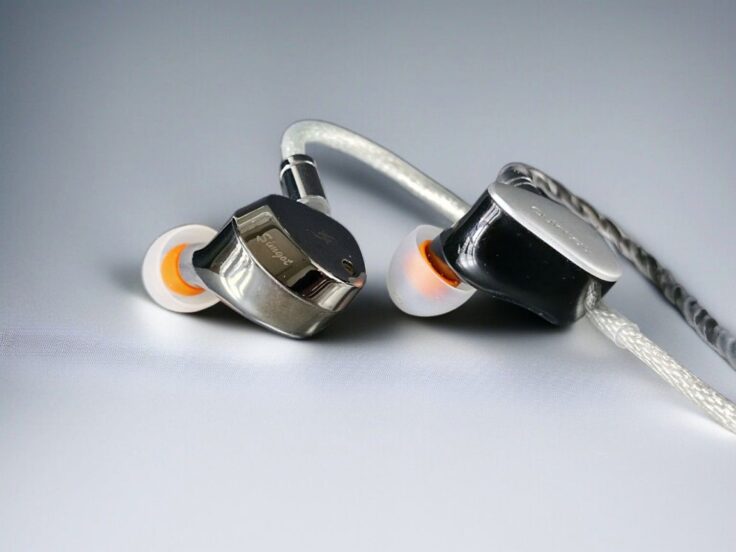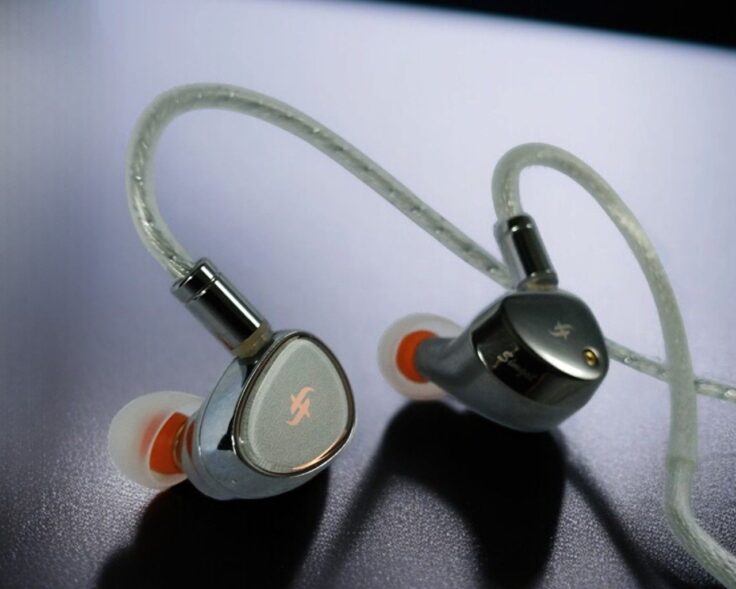The ET142 ($219) is a dual driver in-ear monitor from Simgot. It utilizes a planar magnetic main driver and a piezoelectric tweeter. The ET142 launched recently, in early 2025, more than six years after Simgot’s first planar magnetic headphone, the ET1000. It represents a revival of the ET series, and we might see more planars from Simgot in the future.
MAIN TAKEAWAY
- Excellent technical performance
- Organic timbre
- Full bass and polite mids with the long nozzles
- Neutral tuning with short nozzles at the cost of some refinement
I have personally reviewed most of Simgot’s current lineup and must say I’m a fan of their approach to design, craftsmanship, and tuning. They made a name for themselves with single dynamic driver earphones like the EA1000 ($219), but have recently expanded into hybrid designs with models like the EW300, EM6L, and SuperMix 4. The EM10, Simgot’s current flagship IEM, is also a hybrid, but unfortunately, I have not had the chance to review it.
As mentioned, the ET142’s main component is a 12.5 mm planar magnetic driver, which has a powerful dual-sided grid array magnetic system. The treble gets some help from a multi-layer piezoelectric tweeter, which refines high and ultra-high frequencies.
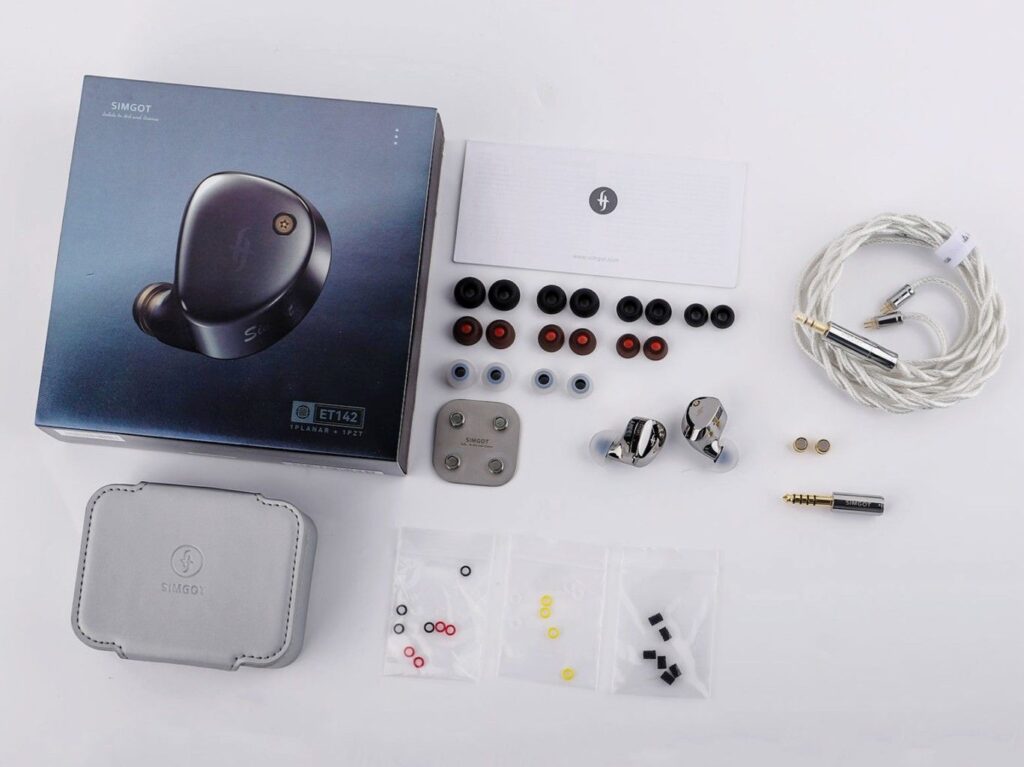
SIMGOT ET142 SPECIFICATIONS
- Drivers: 1 x 12.5mm planar magnetic driver + 1 x multi-layer piezoelectric ceramic driver
- Impedance: 14Ω ±15% (@1kHz)
- Sensitivity: 118dB/Vrms (@1kHz)
- Frequency response: 8Hz–40kHz
- Cable: 732-core mixed oxygen-free copper & silver-plated Litz
- Connectors on earphones: 0.78mm 2-pin
- Cable termination: Interchangeable 3.5mm single-ended & 4.4mm balanced
- In the box: IEMs, cable with plugs, storage box, 9 pairs of ear tips of various types in various sizes, and 4 pairs of tuning nozzles.
Price when reviewed: $219.
You can check the current price and availability here.
- Linsoul: Simgot ET142
The review sample was sent us for this review by Simgot.
BUILD AND COMFORT
The ET142 is made of CNC-machined metal, quite large, and not the lightest IEM I’ve used. However, they are comfortable, feel luxurious, and seem like they can take a beating.
The included LC7 cable, which can also be purchased separately for $69, is made from high-purity oxygen-free copper and silver-plated wires. It is constructed with an impressive 732-core Litz structure and has a high-quality feel but is quite thick and somewhat stiff, which some users might not prefer. The cable uses 0.78mm pin connectors for the earphones and has interchangeable 3.5mm and 4.4mm termination plugs for the audio source.
The ET142 comes with a storage box identical to those supplied with Simgot’s other high-end models like the EA1000 and EA2000. I really like these boxes—they have a silver light gray faux leather finish and a rectangular design with a magnetic lock. They’re light, practical, and perfect for both travel and desktop storage.
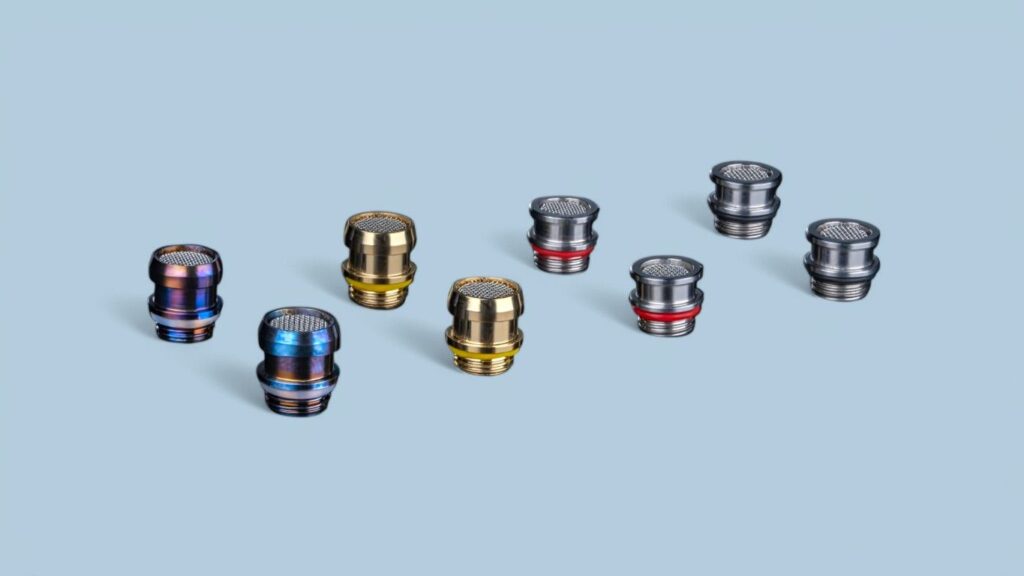
NOZZLES
The ET142 comes with 4 pairs of interchangeable nozzles, which can help you fine-tune the sound. I’ve included Simgot’s descriptions:
LONG NOZZLES:
- Blazed Blue Titanium Nozzle: “Extended treble and airiness for classical and instrumental focus.”
- Gold-Plated Copper Nozzle: “Warm and balanced tuning, perfect for versatile listening.”
SHORT NOZZLES
- Stainless Steel Red Ring Nozzle: “A refined sound profile with enhanced clarity and precision.”
- Stainless Steel Black Ring Nozzle: “Smooth and dynamic tuning with a balanced response across the frequencies.”
Note that these are the manufacturers descriptions; I’ll comment on how I perceive the sound below.
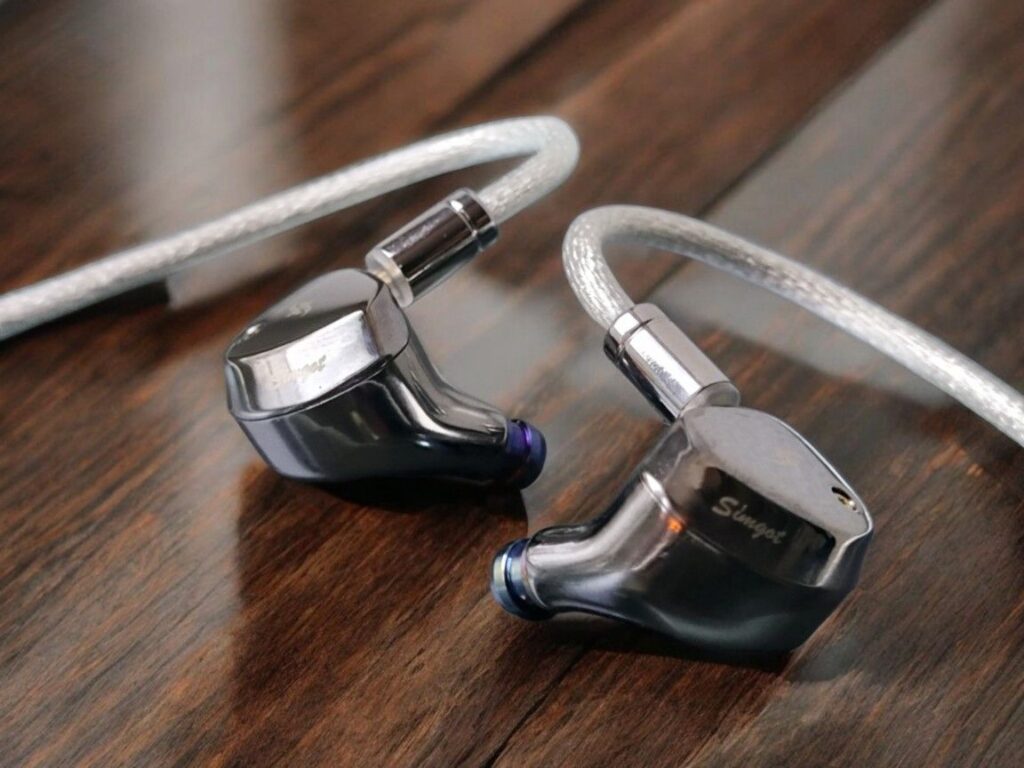
LISTENING IMPRESSIONS
Tuning nozzles can be a very nice feature for the user but makes reviewing earphones more work. However, when I was reviewing the Simgot EA1000 last year, I found its various nozzles to make a significant difference, and I have chosen to test all nozzles on the ET142 more in depth as well. I will share my impressions but also compare it to the EA1000 as a benchmark. The EA1000 has the golden nozzles mounted, which gives the most neutral and balanced tuning of the 3 pairs supplied with it.
I use my SpinFit CP145 tips, which look similar to the ones that are supplied. All have a medium-sized bore. I tried the wide bore Azla SednaEarFit Crystals, which give a slightly crisper and brighter sound.
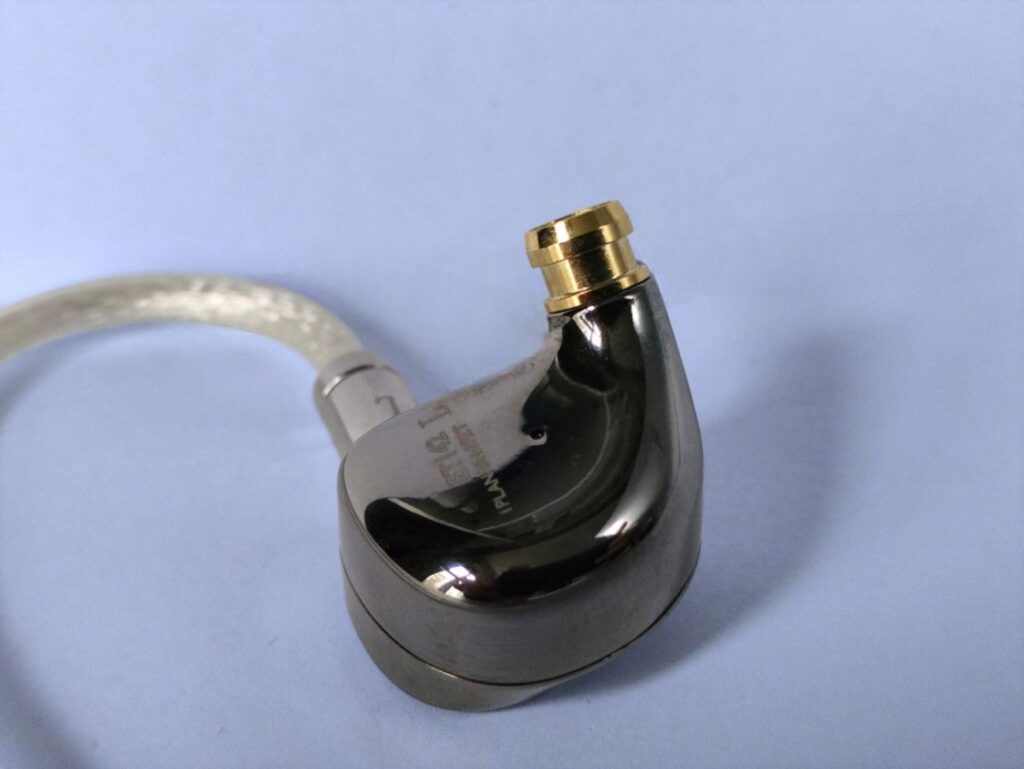
LONG NOZZLES
BLAZED TITANIUM NOZZLES
First, I give the pre-mounted blazed titanium nozzles a thorough listen with the Topping A90 amplifier and ADI-2 DAC FS as the source.
Papirfuglen—album by Moskus
This album, which translates to “paper bird,” is a toned-down, ambient jazz improv journey, which sounds absolutely fantastic with the ET142. The percussion is so spacious that I often think the sounds are coming from my surroundings rather than the earphones. The treble is super-resolved, the bass is full and detailed, and the soundstage is incredible: wide, tall, and very deep.
Jambi by Tool
There is a very good sense of space and separation, and the imaging depth is excellent. The guitars are crisp and textured, the bass is full and very detailed, and also this is with excellent texture. The vocals are well separated but a bit drawn back in the mix. The treble is clear and pronounced, but there’s no annoying sibilance.
Almost Like The Blues by Leonard Cohen
The bass is excellently textured. Vocals are nuanced, and the presentation feels nicely balanced.
Black Crow by Cassandra Wilson
This is a very spacious-sounding track, and the ET142 doesn’t disappoint in terms of soundstage and imaging. The percussion is snappy, and the bass is powerful. The vocals are well balanced in the mix.
As Before by Olga Konkova
The bass is punchy and crisp; the percussion is snappy, and vocals are present but not as much as I’d prefer.
Escape Route by Boris Blank
The bass is quite massive, but in a good way. The treble detail is excellent; the midrange is a bit less pronounced than the rest.
Limit to Your Love by James Blake
The bass quality is absolutely terrific, but the quantity is just too much for me. The midrange and treble are crisp and clear, but sadly, it is overwhelmed by the bass.
S.O.S. by Tingvall Trio
Another jazz track that sounds spectacular with the ET142. Crisp and clear, fantastic imaging, great instrument separation.
Eye of the Day by Marta del Grandi
The bass is quite massive but detailed. The vocals are beautifully nuanced, and the treble is clear and articulate.
Spring 0, 1, 2, and 3 Vivaldi Recomposed by Max Richter
The ET142 sounds delightful, with a beautiful string timbre. The instruments have bite and attack, yet remain natural, never overly crisp or harsh. Cellos and double basses carry plenty of body, providing a strong low-end foundation to the music.
Mahler’s Symphony No. 2 III by Paavo Järvi
The kettledrums sound huge, with great detail and depth. The strings are silky and still have good texture. There’s impressive spaciousness and excellent imaging. The image depth is very good. Dynamics are great.
CONCLUSION—BLAZED TITANIUM NOZZLES
With the blazed titanium nozzles, the ET142 has a sound signature with a quite full sounding bass, neutral treble and slightly polite mids. Starting with the bass, the quality is terrific; it’s tight and well-defined with detail in spades. The midrange is a bit recessed but doesn’t lack in clarity. The treble is very clean and organic, and even though it is quite pronounced, it’s not crisp or harsh in any unpleasant way. General dynamics are also very good, and the soundstage is large with excellent imaging, especially depth-wise.
Comparing the ET142 with the blazed titanium nozzles to the Simgot EA1000 (which has the golden nozzles mounted), the strong and weak points of the ET142 are made very clear. While the ET142 has better technical performance, the EA1000 isn’t very far behind, yet offers a more versatile tuning. The bass of the ET142 can be overwhelming on a certain minority of my tracks, the midrange too recessed, and the treble a bit bright. The EA1000 has a more balanced and coherent presentation. My preference does vary from track to track, however. Generalizations never tell the whole story, and you can read my full comparison if interested.
- SIMGOT ET142 vs. EA1000 Comparison Review
GOLDEN BRASS NOZZLES
I went through my playlist with the golden brass nozzles, and, to be honest, I didn’t find them to be significantly different from the blazed titanium nozzles. If anything, the treble was slightly less pronounced. Visually, they look the same except for the finish and colour of the silicone ring, and neither contains foam or any damping material inside the barrel. The main difference is the material—brass vs. titanium. There might also be a slight variation in the mesh at the tip. If I had two sets of ET142 for a proper A/B comparison, I might pick up on more differences, but for now, they sound pretty similar to me.
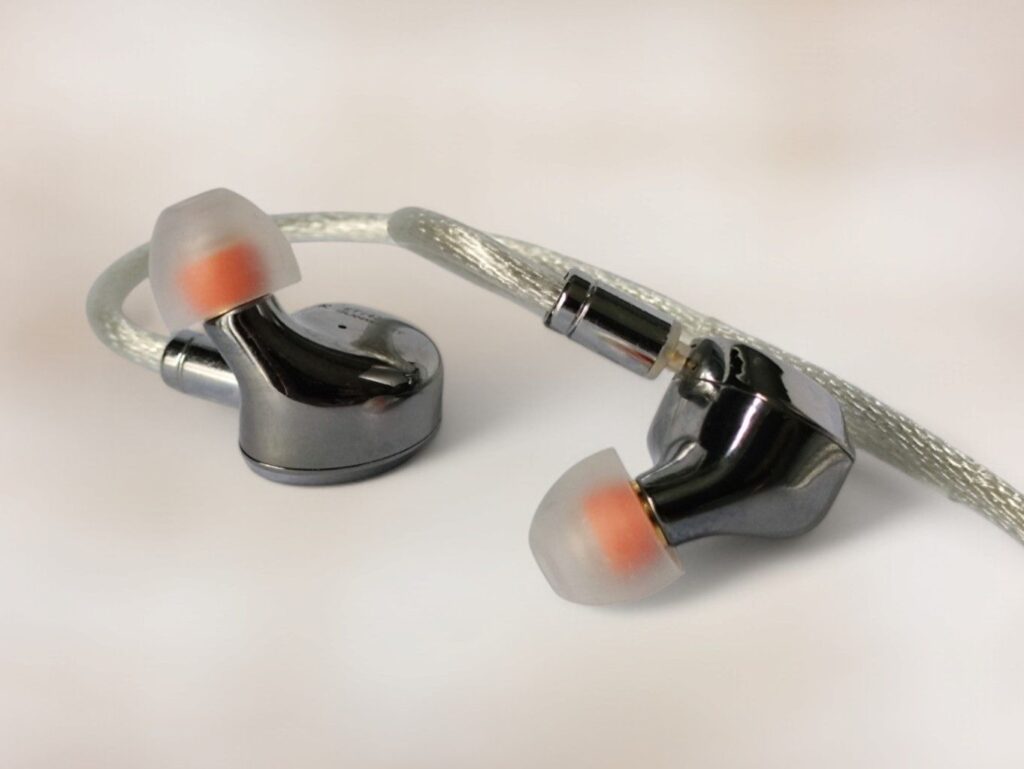
SHORT NOZZLES
The two pairs of short barrel nozzles are significantly different from the long barrel nozzles. They are shorter, filled with black foam, and made of steel.
I’m starting with the black ring nozzles. According to Simgot, these short nozzles offer a “smooth and dynamic tuning with a balanced response across the frequencies.”
Compared to the two long nozzle types, my first impression is that the short black ring nozzles reduce both bass and treble, bringing the midrange—especially vocals—to the forefront. The soundstage feels more intimate. I also need to slightly increase the volume on the amp to get the same loudness.
As I listen through my playlists and compare the ET142 to the EA1000, the impression remains consistent. The ET142 now sounds more like speakers in a very dampened room, whereas the EA1000 gives a sense of reflections and resonances, adding a pleasant sense of airiness. At times, the ET142 can feel slightly over-dampened, while other times, it sounds just right. In conclusion, with the black ring short nozzles, the EA1000 and ET142 sound much more similar than when using the long nozzles on the ET142. I definitely prefer the ET142’s frequency response with these nozzles, but it comes at the cost of a smaller soundstage, reduced imaging, and a lower overall detail level. This makes sense, as the short nozzles are filled with foam, which the sound must pass through.
As for the differences between the two pairs short nozzles, they appear visually identical (except for the colour of the silicone ring)—the barrel and foam look the same. To my ears, they also sound nearly identical. However, both short barrel nozzles create a noticeably different sound profile compared to the long barrel nozzles.
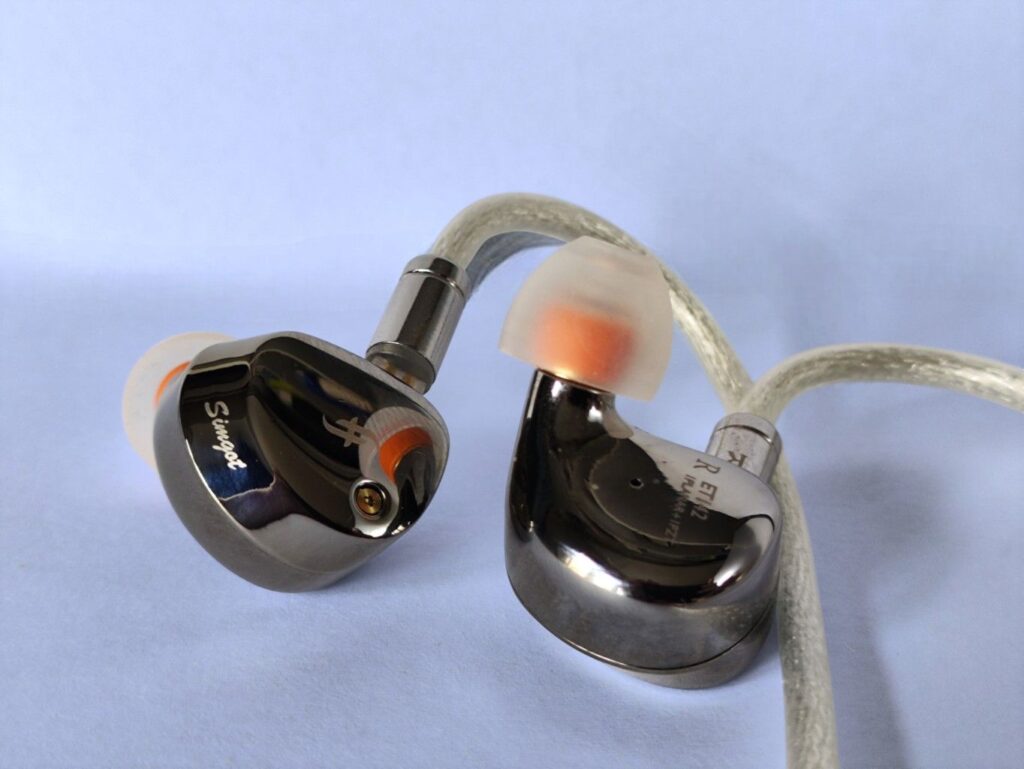
WRAPPING IT UP
LONG NOZZLES
Sound Signature
With the two pairs of long nozzles the ET142 has a somewhat V-shaped sound signature, with elevated bass and treble compared to the midrange
Treble
The treble is very clean, nuanced, and organic. It’s also on the somewhat energetic side, but I did not find it too bright and never experienced any problematic sibilance.
Midrange
While the ET142 delivers a wonderfully detailed midrange, there are certain tracks where I find myself wanting more presence, especially in the upper mids, giving more body and energy to vocals and instruments. For the most part, however, I find it satisfactory.
Bass
The bass is quite powerful but also very well defined with impressive texture and detail.
Soundstage and Imaging
The ET142 offers a large soundstage with excellent imaging. Its stage depth and instrument separation are particularly impressive.
Detail, Dynamics, and Timbre
When it comes to raw detail retrieval, the ET142 excels across the board. Dynamics are also very strong. In terms of timbre, it delivers excellent performance in the bass, midrange, and highs individually, but the overall tonal balance can feel a bit coloured on some tracks.b
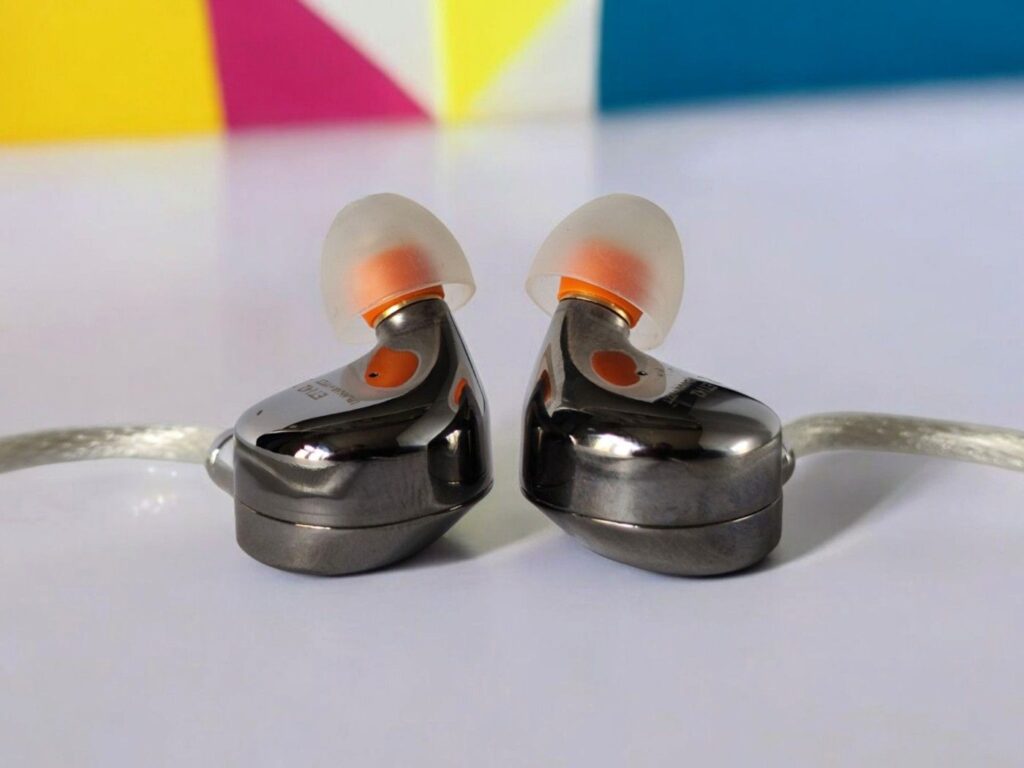
SHORT NOZZLES
Sound Signature
With the short nozzles, the ET142 changes character significantly, becoming more neutral and smoother sounding. The bass quantity is reduced, as is the treble, hence the tonal balance becomes more neutral with a notable increase in relative midrange presence.
Treble
With the short nozzles, the ET142 has a pretty neutral treble presence. The detail level is good, but not as stellar as with the long nozzles.
Midrange
The midrange is much more pronounced with the short nozzles than with the long ones. Personally, as someone who often prefers a warm, lush, mid-centric sound, I’m very satisfied with this change. I do not find that the detail level suffers, as opposed to what happened with the treble.
Bass
The bass quantity is significantly reduced with the short nozzles, bringing it to a more “neutral” level. Unfortunately, this change also leads to a reduction in the outstanding detail and texture in the lower regions that was present before. Don’t get me wrong, the bass quality is still good, but it’s not as outstanding as it was with the long nozzles.
Soundstage and Imaging
The short nozzles make the soundstage of the ET142 more intimate and less spacious, though the imaging is still good.
Detail, Dynamics, and Timbre
Although it still delivers a good performance, I do find that the general detail level is reduced with the short nozzles. Dynamics also suffer a bit. However, when it comes to timbre, I now find it to sound very natural and coherent across the frequency spectrum.
CONCLUDING ON NOZZLES
After trying all four pairs of nozzles, my main takeaway is that with the music I’ve listened to, there is little to no practical difference between the two long barrel nozzles (blazed titanium and golden brass) and between the two short barrel nozzles (stainless steel). I prefer the long barrel nozzles for their superior detail retrieval and larger soundstage, while I favor the short nozzles for their more balanced tonal presentation.
Ideally, I’d love to have all these qualities at once, and I can’t help but wonder how a nozzle with foam with a small hole in the center—allowing some extra sparkle to pass through—would sound.
Although I don’t typically favor a V-shaped tuning, it can certainly be enjoyable, and with the long nozzles, the ET142 still isn’t too far from neutral. Ultimately, I prefer the long nozzles because they allow the ET142 to shine with a more spectacular performance, while the short nozzles provide a better tonal balance but sound less impressive overall.
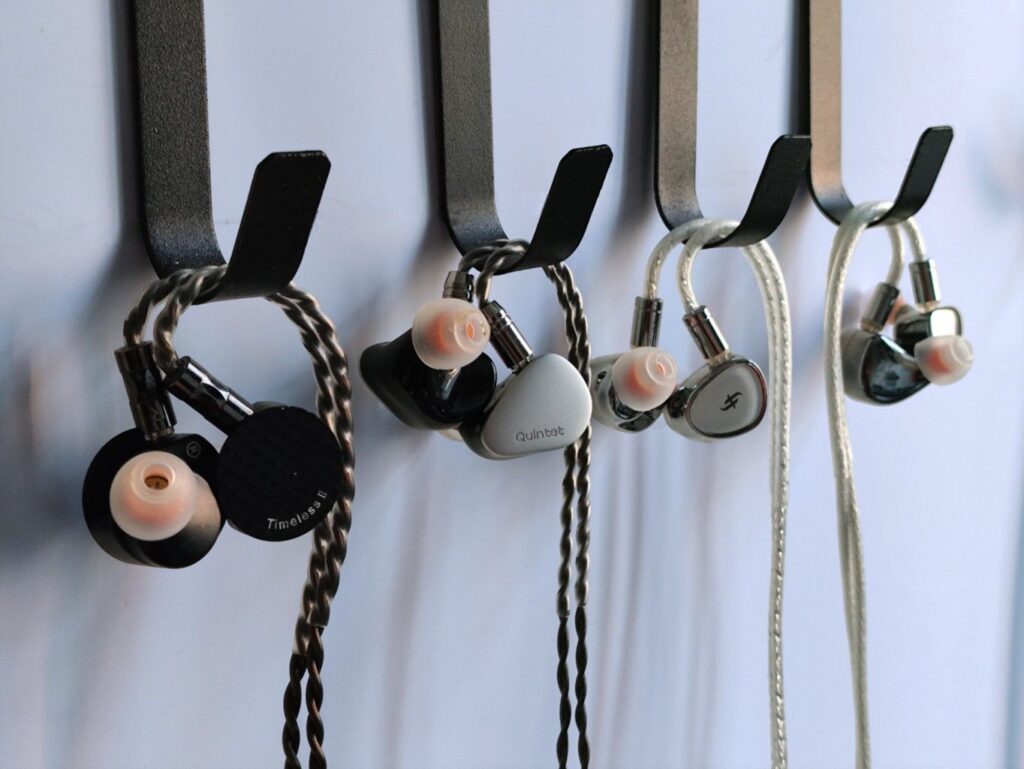
COMPARISONS
SIMGOT EA1000 Fermat vs ET142
The EA1000 ($219) is an excellent single dynamic driver IEM, which I have already mentioned, as I used it as a reference when comparing nozzles on the ET142.
In comparison to the ET142 with the long nozzles, the EA1000 has a more neutral sound signature with less bass and more midrange presence. However, it doesn’t quite match the ET142 in technical performance, particularly in detail retrieval and imaging.
With the short nozzles mounted, the ET142 changes its sound signature to become very similar to that of the EA1000. The two earphones also align much more closely in terms of detail retrieval and imaging capabilities, but with the EA1000 now sounding a bit more spacious.
KIWI EARS QUINTET vs ET142
The Quintet ($219) is an excellent five-driver hybrid that has become a benchmark in its price class. I have only compared it to the ET142 with the long nozzles.
Both the Quintet and ET142 are great-sounding IEMs but present distinctly different tunings. Compared to the ET142 (with the long nozzles), the Quintet offers a more neutral and brighter sound signature, featuring a noticeably more pronounced midrange and less bass emphasis. The Quintet has a slightly dry tonality, while the ET142 delivers a warmer and smoother presentation and maintains a more organic character. The Quintet has a high level of detail, but I find the ET142 to be even better. The soundstage tends to feel larger on the Quintet, though.
7Hz TIMELESS II vs ET142
The Timeless II ($229) is the updated version of the successful planar magnetic single-driver 7Hz Timeless. I only compared it to the ET142 with the long nozzles.
The Timeless II and the ET142 have much more in common than not and are very similar overall. However, though it still has a bass lift, the Timeless II has a more neutral sound signature with slightly less bass and a more energetic upper midrange. It tends to feel more textured, the ET142 more organic. Both deliver great detail. Although very good, the Timeless II cannot always match the soundstage of the ET142.
AMPLIFICATION
I’ve been using the Topping A90 desktop amp for all my testing so far, but now it’s time to check out some portable options.
My POCO F5 phone’s headphone output sounds surprisingly good. I really need to crank up the volume, but it’s impressive. The tiny Jade/FiiO JA11 dongle sounds more open and detailed, though.
The Letshuoer DT03 sounds good, but warmer and darker. I move on to the xDuoo Link2 Bal2, which has a more open tonality with better resolution.
The THX Onyx, works very well. It’s authoritatively dynamic and has great detail. The Dragonfly Cobalt performs quite similarly, both are great matches for the ET142. Finally, the Chord Mojo sounds excellent as always.
In conclusion, the ET142 is not especially picky on the amp, but doesn’t mind scaling with higher quality gear.
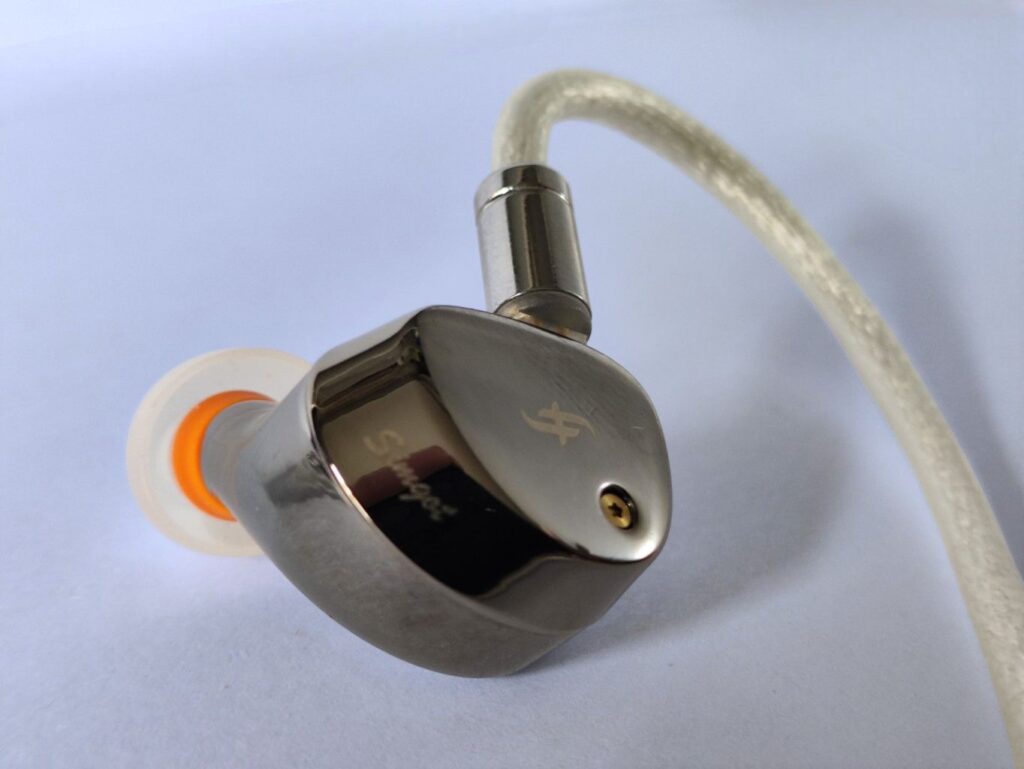
CONCLUSION
The ET142 is an excellent IEM with two distinct optional sound signatures. With the long nozzles, it delivers rich bass, slightly dark mids, and a nicely articulated, liquid-sounding treble, all with a lovely organic character. The short nozzles provide a more neutral tonal balance, and while the technical performance remains strong for the price, I personally find the long nozzles to create a more fascinating listening experience. That said, the nozzles provide added flexibility, and the ability to experiment with ear tips and nozzle combinations has the potential to be very rewarding.
Overall, the ET142—especially with the long nozzles—offers something special. There’s a certain magic to its presentation, and it comes highly recommended.
Thanks for reading. You can support us by purchasing anything using any of our affiliate links.
Any purchase you make on Amazon or Linsoul with any of our affiliate links will give us a small provision at no cost to you.
We only get a provision for items that are not returned, so there’s no incentive for us to recommend something that’s not good.
Linsoul : Headphones, Earbuds, Wireless Earbuds, Desktop DAC/AMP, Portable DAC/AMP, Digital Audio Players,
Amazon: Headphones, IEMs, Headphone Amplifiers, Home Audio or Anything else.
.
If you enjoyed this article or other content on The Headphoneer, you might consider leaving a small donation to keep this website up and running. No donation is too small. Thanks for supporting us!
If you like our work please follow us on Instagram, Facebook and Twitter , it will help us grow. Sharing is caring 🙂


